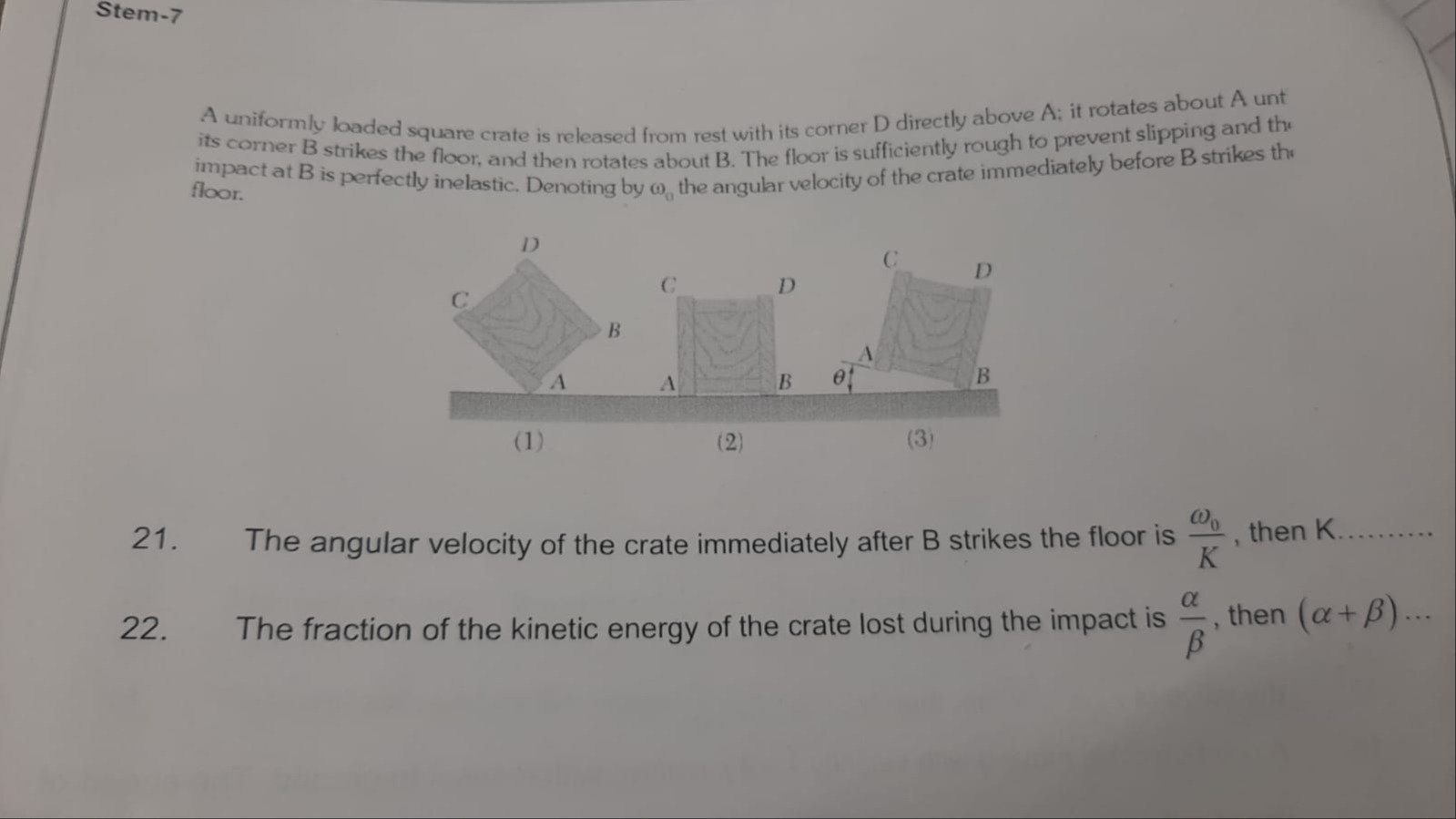Question
Question: A uniformly loaded square crate is released from rest with its corner D directly above A; it rotates...
A uniformly loaded square crate is released from rest with its corner D directly above A; it rotates about A until its corner B strikes the floor, and then rotates about B. The floor is sufficiently rough to prevent slipping and the impact at B is perfectly inelastic. Denoting by ω₀ the angular velocity of the crate immediately before B strikes the floor.

The angular velocity of the crate immediately after B strikes the floor is Kω0, then K..........
The fraction of the kinetic energy of the crate lost during the impact is βα, then (α+β)...
- K=4.
- α+β=31
Solution
We shall show briefly how to get the answers.
Setup:
Let the square crate have side length a and mass m. Choose coordinate origin at corner A. Then the positions are: A = (0,0), B = (a,0), G (center) = (a/2, a/2).
When the crate rotates about A with angular speed ω0 the velocity of any point is v = ω0 × (position vector from A).
Because A is fixed, the total angular momentum about a different point (say, B) is not simply IAω0. In fact, one must “transfer” the angular momentum by writing the contribution from the spin about A and the “orbital” part due to the motion of the center of mass.
Step 1. Find L about B just before impact
Write the total angular momentum about B as the sum of the spin about the center of mass plus the orbital part of the center‐of–mass motion:
LB(before)=Icmω0+m(rG/B×vG).Here
- Icm=6ma2 (for a uniform square),
- rG/B=G−B=(−2a,2a).
- When rotating about A, the center’s position is G=(a/2,a/2) so its velocity is vG=ω0(−a/2,a/2).
Then
rG/B×vG=(−2a,2a)×(−2aω0,2aω0)=(−2a)(2aω0)−(2a)(−2aω0)=−4a2ω0+4a2ω0=0.Thus only the spin contributes:
LB(before)=Icmω0=6ma2ω0.Step 2. Relate to rotation about B immediately after impact
After the inelastic impact at B the crate rotates about B with angular speed ω′. Its moment of inertia about B (using the parallel‐axis theorem) is:
IB=Icm+m(2a)2=6ma2+m2a2=ma2(61+21)=32ma2.Since the impulsive force at B exerts no moment about B the angular momentum about B is conserved:
LB(after)=IBω′.Conservation thus gives:
6ma2ω0=32ma2ω′.Canceling common factors, we find:
ω′=61/32ω0=61⋅23ω0=4ω0.However the problem states that immediately after B strikes, the angular speed is written as
Kω0.Thus comparing, we read off:
K=4.Step 3. Energy loss during the impact
Although angular momentum is conserved, kinetic energy is not. Write the total kinetic energy in any inertial frame as the sum of translational energy of the center of mass plus the rotational energy about the center of mass.
Before impact (rotation about A):
- The center of mass is at G = (a/2,a/2) so its speed is vG=ω0G=ω02a.
- Thus, Kbefore=21mvG2+21Icmω02=21m2a2ω02+216ma2ω02=4ma2ω02+12ma2ω02=3ma2ω02.
After impact (rotation about B with ω′ = ω₀/4):
- The new center of mass (still G) is now at a distance from B of ∣G−B∣=2a, so its speed is vG′=ω′a/2=(ω0a)/(42).
- Then, Kafter=21m(vG′)2+21Icm(ω′)2=21m32⋅2−1a2ω02?
Let’s compute carefully:
- v'_G^2 = \frac{a^2\omega_0^2}{16\cdot 2} = \frac{a^2\omega_0^2}{32}.
Thus,
21mvG′2=21m32a2ω02=64ma2ω02.Next,
21Icm(ω′)2=216ma216ω02=192ma2ω02.Thus,
Kafter=64ma2ω02+192ma2ω02=1923ma2ω02+192ma2ω02=1924ma2ω02=48ma2ω02.The energy lost is:
ΔK=Kbefore−Kafter=3ma2ω02−48ma2ω02=(4816−481)ma2ω02=4815ma2ω02=165ma2ω02.Thus the fraction lost is:
KbeforeΔK=(1/3)ma2ω02(5/16)ma2ω02=165×13=1615.Since this fraction is given as βα with α=15,β=16, the problem asks for α+β=15+16=31.
